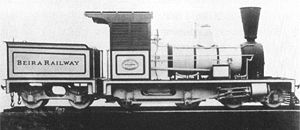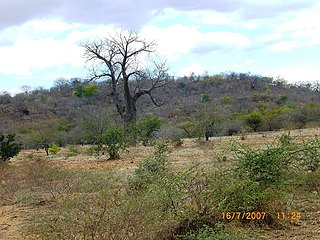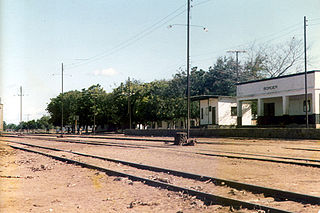| History of Mozambique |
|---|
 |

The history of rail transport in Mozambique began in the latter years of the nineteenth century.
| History of Mozambique |
|---|
 |

The history of rail transport in Mozambique began in the latter years of the nineteenth century.
The Mozambique of the nineteenth century was a Portuguese colony. In the 1870s, there were initial plans to link the then Lourenço Marques – now Maputo – by railway line with the area around Johannesburg in South Africa. The planned line would have provided the independent Boer republics in the north of South Africa with access to a port. However, the province of Transvaal, to which Johannesburg belonged, was then a British possession.[ clarification needed ]
On 1 March 1890, Mozambique's first railway line was opened between Lourenço Marques and Ressano Garcia. [1] Only in 1895 did operations commence on the rest of the line, across the border to Pretoria, as the Delagoa Bay Railway. This line was constructed by the Netherlands–South African Railway Company (NZASM) and was officially inaugurated on 1 January 1895. The line crossed into South Africa at Ressano Garcia and Komatipoort. In connection with the opening of this line, the Gaza Empire in southwestern Mozambique was immediately subjugated by the Portuguese, because it endangered the safety of the rail traffic. [2]
In 1891, Portugal and the United Kingdom signed a contract for the construction of the Beira Railway, to link the Mozambican port of Beira with Salisbury. By 1900, this line was in service, in 1,067 mm (3 ft 6 in) gauge (Cape gauge) throughout. [1]
The Gaza Railway was a 2 ft 6 in (762 mm) railway operating in southern Mozambique from Xai-Xai (former Villa de Joäo Belo) via Manjacaze junction with branches to Chicomo and Mauela. It was constructed in the early 1900s.
At the beginning of the twentieth century, the railway network of Mozambique was expanded. From 1903, a 54 km (34 mi) long line was built from Lourenço Marques to Goba, on the border with Swaziland, so that Swaziland, a British colony at that time, could export its natural resources. In 1909, this line was opened. [1]
In 1912, a contract was signed for the construction of a line from Beira to the Nyasaland Protectorate, now Malawi.
In the north of Mozambique, a line was built from the port of Nacala via Nampula and Cuamba to Nyasaland, where it connected with the Nyasaland rail network. A branch line ran from Cuamba north to Lichinga, near Lake Malawi.
It connects Maputo, in Mozambique, to the city of Somabhula, in Zimbabwe, allowing interconnection with the Beira-Bulawayo railway.
In the province of Zambézia, a 120 km (75 mi) long line was built from Quelimane on the Indian Ocean north to Mocuba. It has no connection with any other railway lines.
All of Mozambique's colonial railways were operated initially by chartered companies, for which the lines were one of their main sources of income, alongside the collection of taxes and profits from agriculture. Only in 1941 was the last concession company nationalized, thus bringing the railways under the total ownership of the Portuguese colonial authorities.
In connection with the independence of Mozambique, the national railway company, Caminhos de Ferro de Moçambique, was founded on 25 June 1975. It was later renamed Portos e Caminhos de Ferro de Moçambique ("Mozambique Ports and Railways") and also took over the operation of sea ports.
As a result of the Mozambican civil war from 1977 to 1992, the railway was severely restricted. Some lines were destroyed by war, such as the Beira–Sena–Moatize and the link from Sena to Malawi (Sena line), after the bridge over the Zambezi at Sena was blown up.
The Nacala–Cuamba line in the north of the country was rebuilt in the 1990s, but the section to the Malawian border remained impassable. [3] In 2004, Mozambique was given a loan from the World Bank to rebuild several lines. [4] Also in 2004, the CCFB, 51% owned by two Indian companies and 49% owned by the CFM, acquired the concession for the operation of the Beira Railway and the rebuilt Sena line. [5]
In 2008, the route length of the network as a whole was 3,100 km (1,926 mi). [6] Since then, several other lines have been reopened.

Modes of transport in Mozambique include rail, road, water, and air. There are rail links serving principal cities and connecting the country with Malawi, Zimbabwe and South Africa. There are over 30,000km of roads, but much of the network is unpaved.

Portuguese Mozambique or Portuguese East Africa were the common terms by which Mozambique was designated during the period in which it was a Portuguese colony. Portuguese Mozambique originally constituted a string of Portuguese possessions along the south-east African coast, and later became a unified colony, which now forms the Republic of Mozambique.

LAM - Mozambique Airlines, S. A. or Linhas Aéreas de Moçambique, Ltd., operating as LAM Mozambique Airlines, is the flag carrier of Mozambique. The airline was established by the Portuguese colonial government of Mozambique in August 1936 as a charter carrier named DETA - Direcção de Exploração de Transportes Aéreos, and was renamed in 1980 following reorganisation. LAM Mozambique Airlines is based in Maputo, and has its hub at Maputo International Airport. It operates scheduled services in Southern Africa. The company is a member of the International Air Transport Association, and of the African Airlines Association since 1976.
The Beira Railroad Corporation, or CCFB, was a joint venture railway company that was responsible for operating the railway lines in central Mozambique. It was formed to reform the railway lines that run from the Port of Beira, Mozambique, originally linking to Zimbabwe, although it later also linked to Malawi.

Moatize is the principal town and administrative center of Moatize District in western Mozambique's Tete Province. It is located on the eastern side of the Zambezi River at the confluence of the Moatize and Revuboe Rivers. After Tete, it is the second largest urban area, by population, in western Mozambique.

Malawi Railways was a government corporation that ran the national rail network of Malawi, Africa, until privatisation in 1999. With effect from 1 December 1999, the Central East African Railways consortium led by Railroad Development Corporation won the right to operate the network. This was the first rail privatisation in Africa which did not involve a parastatal operator.

The Port of Beira is a Mozambican port located in the city of Beira, capital of the Sofala Province. It is located in Sofala Bay, which forms a huge complex with the mouth of the Pungoe River, known as the Beira estuary, facing the Mozambique Channel. It is the second largest port in Mozambique, built to replace the port of Old Sofala in the 1890s.
Articles related to Mozambique include:

Portos e Caminhos de Ferro de Moçambique is a state-owned company that oversees the railway system of Mozambique and its connected ports.
Ethnic Chinese in Mozambique once numbered around five thousand individuals, but their population fell significantly during the Mozambican Civil War. After the return of peace and the expansion of Sino-Mozambican economic cooperation, their numbers have been bolstered by new expatriates from the People's Republic of China.
Railway stations in Mozambique include:
Malawi Railways is the national rail network in Malawi, run by a government corporation until privatisation in 1999. As of 1 December 1999 the Central East African Railways, a consortium led by Railroad Development Corporation, won the right to operate the network.
Teodomiro Alberto Azevedo Leite de Vasconcelos was a Mozambican journalist and writer. He was a member of Associação dos Escritores Moçambicanos.
CLIN, or the Sociedade do Corredor Logístico Integrado do Norte, is a business company related to logistics, whose main business is railway management in Mozambique and Malawi. The company is a joint venture.

The history of rail transport in Malawi began shortly after the turn of the twentieth century.

Nacala railway, also known as Northern Corridor railway and Nacala Corridor railway, is a railway line that operates in northern Mozambique on a 912 kilometres (567 mi) line that runs west from the port city of Nacala, crossing the central region of Malawi, connecting with the coal belt of Moatize, in northwest Mozambique. It is connected to the Dona Ana-Moatize railway branch and the Sena railway (Chipata-Lilongwe-Blantyre-Nhamayabue-Dondo). It also has a 262 kilometres (163 mi) branch line from Cuamba to Lichinga.

Pretoria–Maputo railway, also called Delagoa Bay railway, Iron railway and Eastern railway, is a railway that connects the city of Maputo, Mozambique, to the city of Pretoria, in South Africa. It is 567 km long, in 1067 mm gauge. The Mozambican section, between Maputo and Ressano Garcia, is managed by the state-owned Mozambique Ports and Railways (CFM) company, and it is officially known in Mozambique as the Ressano Garcia Line; in turn, on the South African stretch, between the town of Komatipoort and city of Pretoria, the administration is done by the company Transnet Freight Rail.

Sena railway, also called Shire Highlands railway, Dondo-Malawi railway and North-South Malawi railway, is a railway that connects Dondo, Mozambique, to Chipata, in Zambia. It is c. 1000 km long, in a 1067 mm gauge.

Limpopo Railway, also called Gweru-Maputo railway, is a railway that connects the city of Maputo, Mozambique, to the city from Somabhula, in Zimbabwe. It is 900 km long, in a 1067 mm gauge.
![]() Media related to Rail transport in Mozambique at Wikimedia Commons
Media related to Rail transport in Mozambique at Wikimedia Commons